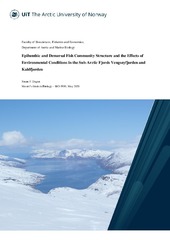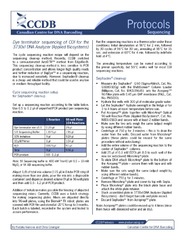Mastergradsoppgaver i biologi: Nye registreringer
Viser treff 201-220 av 429
-
Epibenthic and Demersal Fish Community Structure and the Effects of Environmental Conditions in the Sub-Arctic Fjords Vengsøyfjorden and Kaldfjorden
(Master thesis; Mastergradsoppgave, 2020-06-01)Epifauna are organisms that live on, or close to, the sediment surface and commonly consist of taxa such as sea anemones, sea/brittle stars, and crustaceans. These communities have an important role in redistributing and remineralizing marine organic matter, and as prey for commercially important shellfish and fish. The structure of epibenthic communities can be important indicators of anthropogenic ... -
Sympagic-pelagic coupling and vertical export in two seasonally ice-covered fjords. Study of the physical and biological drivers in the sub-Arctic Ramfjorden (Norwegian mainland) and the Arctic Van Mijenfjorden (Svalbard archipelago) during early spring bloom.
(Master thesis; Mastergradsoppgave, 2020-06-01)Fjords are important high latitudes ecosystems, many have beside planctonic ones, a unique ecosystem associated with seasonal ice cover. During the development of the spring season conditions, two major type of primary producers contribute highly to the biomass production: sea-ice algae inhabiting brine channels and bottom surface of the ice (sympagic algae) and phytoplankton, living in the water ... -
Hungry during migration? Humpback whale movement from the Barents Sea to a feeding stopover in northern Norway revealed by photo-ID analysis
(Master thesis; Mastergradsoppgave, 2020-06-01)In the last nine winters, a humpback whale feeding aggregation has been observed in the nearshore waters and fjords of northern Norway. This seasonal humpback whale occurrence is presumably driven by a shift in the overwintering distribution of Norwegian spring spawning (NSS) herring into these coastal areas. Eastern North Atlantic humpback whales feed during summer in relative remote regions in ... -
Stability of space use in Svalbard coastal female polar bears: Intra-individual variability and influence of kinship
(Master thesis; Mastergradsoppgave, 2020-06-01)Philopatry influences the distribution of animals and can lead to the formation of kinship-based population structures when relatedness among individuals is tightly linked to their proximity. Two different polar bear ecotypes exist in the Barents Sea sub-population: “coastal” bears and “offshore” bears. Coastal bears remain year-round within the Svalbard archipelago whereas offshore bears follow the ... -
Homesick plants - a study on Plant-soil feedback in home and foreign soil following a latitudinal sampling gradient from Morocco to Svalbard
(Master thesis; Mastergradsoppgave, 2020-06-01)Plant-soil feedbacks receive increasing attention as impactors of plant performance and drivers of plant community composition. How plant-soil feedbacks act in introduction events regarding both native and foreign species is a topic requiring more research. In this aspect, two particular theories are of interest, Home-field advantage, and Enemy-release. The former predicts that plants perform best ... -
Can aquaculture impact the surrounding biodiversity? A metabarcoding assessment
(Master thesis; Mastergradsoppgave, 2020-06-01)World’s population growth and rise in food consumption per capita have led to increased food demand and overexploitation of natural resources in recent decades. Such increase has threatened the global feeding schemes to maintain a balance between food supply and demand. Although “The Blue Revolution” promised to fill such gap and simultaneously alleviate the overexploitation of the oceans, deterioration ... -
Do the predators of Yamal have a learning effect of artificial nests?
(Master thesis; Mastergradsoppgave, 2020-06-01)Many artificial nest studies that goes over several years place the nests in the same location each placement. Over the years there is a chance that the predators learn where the nests are placed and that can give skewed results. The goal of my study is to see if the predators learn where the nests are located. This was done over three study sites on the Yamal peninsula. In two of the study sites ... -
eDNA metabarcoding of amoebic gill disease (AGD) pathogens exposes potential vectors and reservoirs
(Master thesis; Mastergradsoppgave, 2020-05-31)Aquaculture worldwide is under constant scrutiny and financial pressure to maintain fish health, while providing an essential food source to a growing populace. To assist in monitoring mariculture sites and preventing harmful diseases, we tested a recently proposed method of trace pathogen detection using eDNA metabarcoding. The target pathogen, Paramoeba perurans, is the etiological agent of AGD, ... -
The Demersal Fish Community on the West Spitsbergen Shelf. Biodiversity, species composition, distribution and temporal changes in relation to climate.
(Master thesis; Mastergradsoppgave, 2020-05-29)This thesis explores a historical time series of trawl stations on the West Spitsbergen Shelf (WSS), aiming to understand the spatial and temporal variability of the demersal fish communities in the region. Abundance data of 42 fish species are used to investigate the species composition, richness, and diversity across six different areas under different environmetal influence. The results indicate ... -
Interannual variability (2014-2019) of hydrography, fluorescence and nutrient distribution in Vestfjorden, Lofoten
(Master thesis; Mastergradsoppgave, 2020-06-01)Vestfjorden is an area of great ecological relevance since it is one of the main spawning areas of North East Atlantic cod. The survival rate of the cod larvae depends greatly on the abundance of zooplankton, which in turn depends on phytoplankton. Due to the extreme seasonality of high latitude fjords with a short productive season, understanding the phytoplankton distribution in spring is crucial. ... -
Dietary vs. light stimulated smoltification: effects on smolt development and appetite regulation in pre- and post- smolts
(Master thesis; Mastergradsoppgave, 2020-05-22)The transfer of smolt from freshwater (FW) to seawater (SW) is a critical stage in the farming of Atlantic salmon (Salmo salar) with mortalities of up to 15 % after transfer. One of the reasons for this loss is suboptimal smolt quality. It is therefore important to ensure that the fish are fully SW adapted before transfer to SW. Traditionally, smoltification is stimulated by exposing the fish to a ... -
Analysis of xyloglucan-modifying genes and enzymes at graft-junctions of tomato plants
(Master thesis; Mastergradsoppgave, 2020-05-16)Grafting is a widely used technique for propagation of plants in both agriculture and horticulture worldwide and involves combining two or more plants into one chimeric plant, ultimately with a shared vascular system. Benefits of grafting such as pathogen resistance, increase in fruit yield and abiotic stress tolerance have long been known, but the biological mechanisms of how plants graft are still ... -
Addressing the aquatic vertebrate community of Vågsfjorden 2019 with the use of Environmental DNA
(Master thesis; Mastergradsoppgave, 2020-05-15)In order to estimate biodiversity or do species counts, detramental techniques such as trawling or longlining have been used. Lately techniques used to monitor, such as baited remote underwater video systems and environmental DNA have been tested as possible methods to investigate species richness and abundance, the latter which will be used in this thesis. Using eDNA methodology, a northern ... -
Genetic population structure of the northern shrimp (Pandalus borealis) along the Norwegian coast
(Master thesis; Mastergradsoppgave, 2020-05-15)The coastal shrimp (Pandalus borealis) represent an important income for a small-scale fishery. The more economical important fishery of shrimp is located offshore. There is sparse information and literature regarding the coastal shrimp, and it is a lot we do not know about the species that inhabits our coast and fjords. Genetic research will provide more information on the species in these areas. ... -
Bearded seal vocalisations across seasons and habitat types in Svalbard (Norway)
(Master thesis; Mastergradsoppgave, 2019-08-15)Male bearded seals use vocal displays to attract females and compete with other males during the mating period, making it possible to monitor breeding populations using passive acoustic monitoring (PAM). This study analysed year-round acoustic data from underwater recorders at three sites with different environmental conditions in Svalbard (Norway). Male bearded seals vocalised for an extended ... -
An interannual study of foraging behaviour in sympatrically breeding macaroni Eudyptes chrysolophus and chinstrap penguins Pygoscelis antarcticus at Bouvetøya
(Master thesis; Mastergradsoppgave, 2019-08-15)Species are likely to segregate their ecological niches to minimize competition for resources, but for centrally foraging predators that breed on sub-Antarctic islands in the Southern Ocean the possibility of niche segregation may be minimal. This study is the first to examine the spatial and trophic aspects of the foraging niche of sympatrically breeding macaroni and chinstrap penguins at the ... -
Denning phenology of polar bears (Ursus maritimus) in the Barents Sea population
(Master thesis; Mastergradsoppgave, 2019-07-31)Timing reproductive effort to match food availability is important due to high energetic costs of reproduction. Female polar bears need sufficient time in the den to nurse cubs until they are big enough to withstand the Arctic environment, however females’ emergence from the den needs to be synchronized with ringed seal pupping peak, which is a crucial energy source for polar bears. The phenology ... -
Allochthonous Allelopathy. Effects of Empetrum nigrum chemical interference on plant development
(Master thesis; Mastergradsoppgave, 2016-05-20)The dwafshrub Empetrum nigrum uses phenolic compounds exuded by its leaves to depress the germination and growth of its surroundings. The allelopathic effect has, only been studied in areas immediately surrounding the plant (autochthonous allelopathy) but not in an open system apptoach that takes into account that a multitude of EMpetrum nigrum leaves get introduced into new environments through ... -
Species validity of five common northern/Arctic spring bloom diatoms: a combined morphological and molecular study
(Master thesis; Mastergradsoppgave, 2020-02-15)Relevant taxonomical morphological characters of five common spring bloom centric diatoms, preliminary identified as Attheya longicornis Crawford & Gardner, Chaetoceros furcellatus Yendo, Porosira glacialis Jørgensen, Coscinodiscus sp. and Skeletonema marinoi Sarno & Zingone were observed and described using light and scanning electron microscope. Further, samples of cultured diatoms were sent to ... -
Investigating population genomic structure of salmon lice (Lepeophtheirus salmonis) in northern Norway
(Master thesis; Mastergradsoppgave, 2019-05-14)Salmon louse (Lepeophtheirus salmonis) is a parasitic copepod that causes significant damage to Atlantic salmon (Salmo salar) and incurs significant costs to the salmonid aquaculture industry. In Norway, the industry has been coping with salmon lice issues with various methods such as chemical treatments, but it has resulted in an acquisition of resistance in salmon lice towards the existing delousing ...


 English
English norsk
norsk


















